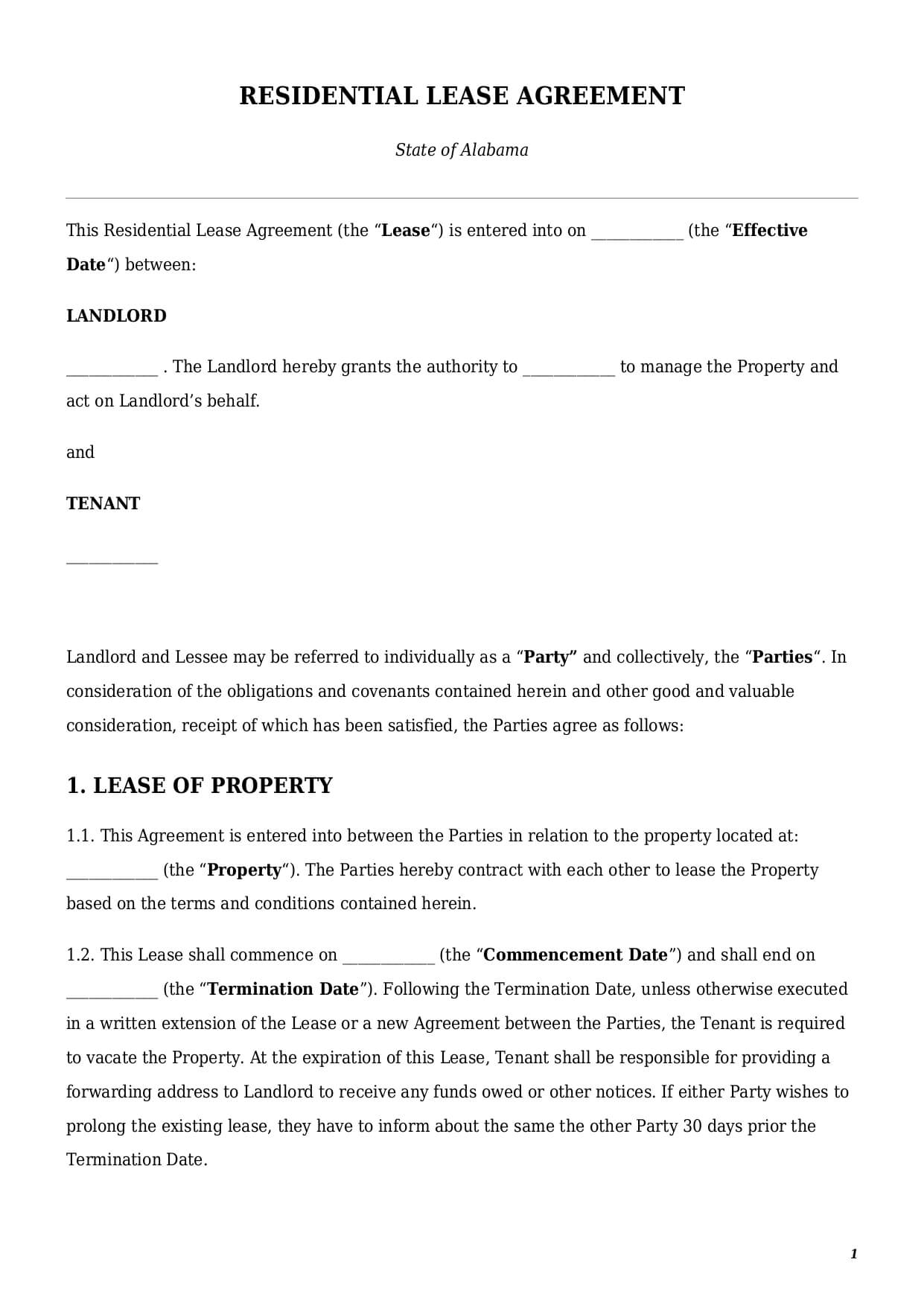Residential Lease Agreement
Reviews


What is a Residential Lease Agreement?
A residential lease agreement is a legally binding contract between the owner of a property and a tenant who wishes to rent it. This contract helps to set out the most important terms and conditions for renting residential property.
A residential lease agreement template is being created between the owner, known as a landlord, and a tenant (i.e., a person who wishes to live in a rented property). A landlord under the residential lease can be an individual or a company, while a tenant should always be a physical individual. It is a common practice when a residential lease agreement is signed by a management company that acts on behalf of a landlord. This is especially the case if a landlord does not have time to deal with tenants or has several properties under administration.
As a rule of thumb, a residential lease agreement form is used to rent a property for a long period of time. Therefore, if you are an owner of a property who wishes to rent it out for a short period of time, it is better to use a short-term rental agreement instead.
A legally binding residential lease agreement template should contain the following key elements:
- duration of rental period (from a few months to a few years);
- amount of monthly rent payments and other additional charges (e.g., utilities bills, county taxes, etc.);
- amount of security deposit;
- detailed rules for property usage (e.g., a landlord may not allow pets within the rented property);
- termination clause and dispute resolution.
Every state law within the USA contains its own rules regarding the content and application of residential lease agreements. For example, when creating an Arizona residential lease agreement form, a security deposit should be returned within 14 days after the lease termination. Therefore, inclusion of a longer period may violate state laws. Contrary to that, while drafting an Illinois standard residential lease agreement, a landlord has a period of 30 days maximum to return the deposit upon the lease termination.
How to Write a Residential Lease Agreement?
Writing a residential lease agreement template can be a challenging task. Therefore, we created for you a list of essential tips to keep in mind:
Details of the Parties
When entering a residential lease agreement, make sure you know the landlord. A landlord is a person who owns the property and thus has a right to rent it out. If you sign a residential lease agreement with a management company, ask them if they have the proper rights to represent a landlord. Usually, there should be a kind of services agreement or a simple power of attorney between a landlord and a management company.
The tenants who should sign a residential lease agreement template are individuals that plan to reside in a rented property. Thus, if this is a family, then all family members should be listed as tenants.
Description of the rented property
Another essential pillar to every agreement on lease residential template is a property’s description. It should include:
- size (in sq. ft.);
- detailed address and location;
- details of a parking space (if applicable);
- description/list of all amenities and furniture within a rented property;
- description of a property’s overall condition.
Duration of the lease
The duration of the lease can be any term from a few weeks or months to several years. Parties may also include an automatic prolongation clause in their residential lease agreement template. Once included, a lease is being automatically prolonged for the same period of time after its termination, unless terminated by either party in writing.
It is vital to include a start date for the lease as well—i.e., the date on which a tenant can move in. A start date can be the same date as the date of signing the residential lease agreement template or any other date.
Monthly rental payments
Another key element for every residential lease agreement template is the amount of rent payments. Rent should be paid every month, unless another frequency is agreed upon by the parties. It is also crucial to indicate available payment methods like bank withdrawal, cash, check, etc.
Parties may also set up late fees once a tenant fails to pay rental payments in a timely manner. The way how late fees should be paid by a tenant may differ depending on the state. For example, for a California residential lease agreement, a tenant has 3 days to cure the breach or vacate the property.
Payment of security deposit
A security deposit is used to protect a landlord from possible breach of a residential lease agreement by a tenant. As a rule of thumb, a security deposit is being returned upon termination of the lease. If there is irreparable damage to a property or debts, a security deposit can be used by a landlord to cover in full or in part such damage.
It is crucial to establish the period of time within which a landlord should return a deposit once the lease ends. Some state laws, however, provide their own regulation. For example, when creating a Florida residential lease agreement, a security deposit should be returned within the first 15 days after the lease termination. This is a maximum period of time that cannot be overthrown by a landlord or tenant. Some other states may have a longer period of time for a landlord to return a deposit. For instance, according to a standard Texas residential lease agreement, a landlord has up to 30 days to make a return.
Utilities bills and charges
Utilities are not included in the monthly payment and should be covered by either party. Thus, from the very outset, parties should agree on every separate charge and bill they have to split in between. The most common bills and charges a rental property may have are the following:
- electricity and water bills;
- phone and Wi-Fi;
- gas;
- country or property tax;
- trash collection (if applicable), etc.
Household rules and restrictions
According to a residential lease agreement, a tenant can use a rented property for residential purposes only. Besides that, a landlord may wish to consider the following limitations:
- smoking policy;
- pets policy;
- maintenance responsibility (usually a landlord should be responsible for major repairs, while a tenant for minor repairs);
- quiet hours (e.g., no parties after 8 pm);
- guest policy (e.g., a guest cannot stay longer than one night).
Termination clause
A good residential lease agreement template should include a termination clause. This clause defines when and how the lease should be terminated. As a general rule, a residential lease agreement expires automatically upon its termination date.
If, however, there is no termination date, the lease agreement can end by either party’s will. This could be done by sending the other party advance written notice about the termination. For example, according to the Florida residential lease agreement, a landlord can request immediate termination of the lease if a tenant cannot pay the monthly lease within 14 days after the due date.
Signatures of the parties
For a residential lease agreement template to become a legally binding document, it should be signed by both parties. It does not matter if a document is signed by hand or using an e-signature. It is highly recommended for both parties to keep at least one copy of the signed residential lease agreement for their internal record. If any dispute pops up in the future, you always have written proof at hand.
Get a customized Residential Lease Agreement Template at Faster Draft
Faster Draft allows you to customize a standard residential lease agreement for any state. Follow a few simple steps below:
- Press the button “Create Document”
- Answer a few simple questions in the questionnaire
- Select a document’s format—Residential Lease Agreement PDF or Word
- Make a payment
- Your personalized standard residential lease agreement template is ready for download.
Table of content
Frequently Asked Questions (FAQ)
-
1. What is a standard residential lease agreement?
A standard residential lease agreement includes the following mandatory clauses:
- Parties’ names;
- Property address;
- Lease term (start and end dates);
- Monthly rent and payment rules;
- Security deposit;
- Termination clause; and
- Signature of both parties.
-
2. What are the requirements for a Texas residential lease contract?
As a general rule, a Texas residential lease agreement should contain usual mandatory elements like names of parties, property description, payment and security deposit terms, and a termination clause. However, on top of that, a template for a Texas residential lease should contain the following additional considerations:
- A security deposit should be returned within 30 days of the end of the lease;
- A tenant should be able to cure any breach of a contract within 3 days maximum.
-
3. What is the difference between a residential lease and a commercial lease agreement?
A commercial property lease agreement is used to rent out property for doing business. The properties that are being rented out under the commercial lease agreement are warehouses, factories, shops, bars, offices, and other commercial premises.
Contrary to that, a residential lease is used to rent a property in order to reside in it.

Looking for something Different?
Start typing to find out our collection of legal documents and contract templates
